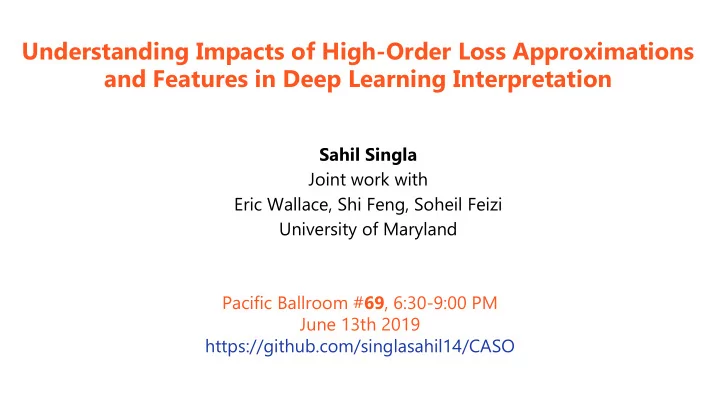

Understanding Impacts of High-Order Loss Approximations and Features in Deep Learning Interpretation Sahil Singla Joint work with Eric Wallace, Shi Feng, Soheil Feizi University of Maryland Pacific Ballroom # 69 , 6:30-9:00 PM June 13th 2019 https://github.com/singlasahil14/CASO
Why Deep Learning Interpretation?
Why Deep Learning Interpretation?
Why Deep Learning Interpretation? Deep neural network Classified as y=0 (low-grade glioma)
Why Deep Learning Interpretation? Deep neural network Classified as y=0 (low-grade glioma) Saliency map to highlight salient features We need to explain AI decisions to humans
Assumptions of Current Methods Loss function
Assumptions of Current Methods Loss function 1. Linear approximation of the loss
Assumptions of Current Methods Loss function 1. Linear approximation of the loss 2. Isolated features : perturb (i) keeping all other features fixed
Assumptions of Current Methods Loss function 1. Linear approximation of the loss 2. Isolated features : perturb (i) keeping all other features fixed
Desiderata of a New Interpretation Framework
Desiderata of a New Interpretation Framework Loss function
Desiderata of a New Interpretation Framework Loss function 1. Quadratic approximation of the loss
Desiderata of a New Interpretation Framework Loss function 1. Quadratic approximation of the loss 2. Group features: find group of k pixels that maximizes the loss
Confronting the Second-Order term
Confronting the Second-Order term ● Optimization can be non-concave maximization
Confronting the Second-Order term ● Optimization can be non-concave maximization ● Hessian can be VERY LARGE: ~150k x 150k for 224 x 224 x 3 input
Confronting the Second-Order term Concave for > L/2 where L is the largest eigenvalue of ● Optimization can be non-concave maximization ● Hessian can be VERY LARGE: ~150k x 150k for 224 x 224 x 3 input
Confronting the Second-Order term Concave for > L/2 where L is the largest eigenvalue of ● Optimization can be non-concave maximization ● Hessian can be VERY LARGE: ~150k x 150k for 224 x 224 x 3 input Can efficiently compute Hessian vector product
When Does Second-Order Matter?
When Does Second-Order Matter? For a deep ReLU network: Theorem: •
When Does Second-Order Matter? For a deep ReLU network: Theorem: • Theorem: If the probability of the predicted class is close to • one and the number of classes is large:
Empirical results on the impact of Hessian
Empirical results on the impact of Hessian Confidence of predicted class RESNET-50 (uses only ReLU )
Empirical results on the impact of Hessian Confidence of predicted class Confidence of predicted class SE-RESNET-50 (uses Sigmoid ) RESNET-50 (uses only ReLU )
Second-Order vs First Order (qualitative)
Second-Order vs First Order (qualitative)
Second-Order vs First Order (qualitative)
Confronting the L 1 term
Confronting the L 1 term
Confronting the L 1 term y = |x| Not smooth at 0 term is non-smooth ●
Confronting the L 1 term y = |x| Not smooth at 0 term is non-smooth ● ● How to select ?
Confronting the L 1 term y = |x| Not smooth at 0 Use proximal gradient descent to optimize the objective. term is non-smooth ● ● How to select ?
Confronting the L 1 term y = |x| Not smooth at 0 Use proximal gradient descent to optimize the objective. term is non-smooth ● ● How to select ? Select the value that induces sparsity within a range (0.75, 1).
Impact of Group Features
Impact of Group Features First-Order
Impact of Group Features First-Order Second-Order
Conclusions A new formulation for interpretation ● ➢ Second-Order information ➢ Group Features Efficient Computation ● Pacific Ballroom #69 , 6:30-9:00 PM https://github.com/singlasahil14/CASO
Recommend
More recommend